|
With a regular television transmission on ultra-short waves, Germany is at present taking a lead in television development in Europe. Apparatus for the reception of these, transmissions is being developed by a number of manufacturers.
During the past year, and particularly in recent months, there has been great activity in the field of television in Germany. The German Government is anxious to encourage television. Even so, the only prospect of television at present seems to be on ultra-short waves. German investigators all use twenty-five picture changes and 180 lines, with 40,000 picture elements, and thus obtain pictures far in advance of the current Post Office transmissions.
Some examples of the progress made and shown at the Berlin Exhibition will be briefly mentioned.
The Principal Exhibits
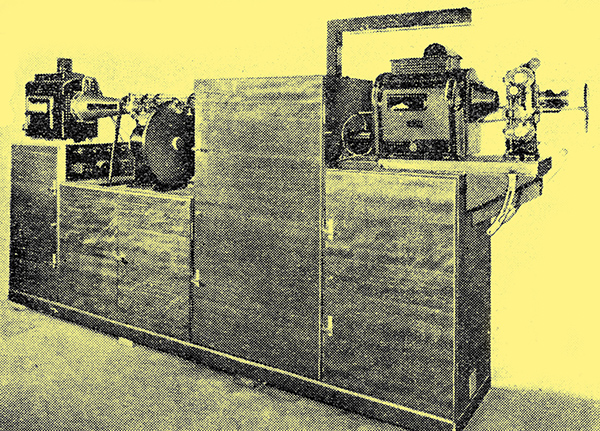
The Fernseh A G continuous intermediate film television projection receiver.
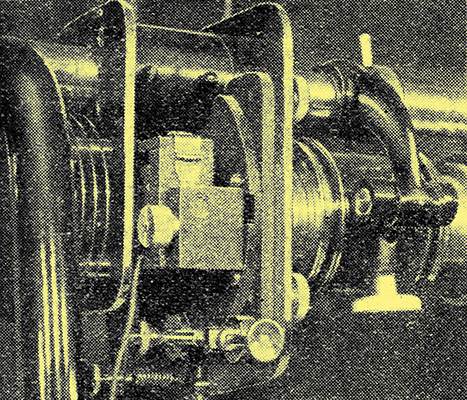
The Fernseh A G projection receiver, a close-up view of the Kerr cell unit which modulates the light.
The Fernseh A G has been able, to improve to a remarkable extent its well-known 'intermediate film' process. In this system the object to be transmitted is first filmed, and the film still wet (in fact, five to ten seconds after exposure) is passed through the televisor and scanned. Formerly it was necessary to use a new film for every record; now, this is no longer necessary. A blank film in an endless band is now used. A sensitised layer is deposited on this by a special apparatus. After passing through a drying chamber the film arrives in the recording camera where it is exposed, developed, fixed, and led to the television transmitting apparatus. Once the picture has been scanned, it is wiped out from the film by another process: a new sensitive layer is deposited on it, and the whole circle repeated. Another accomplishment of the Fernseh A G this year is the projection of television pictures to a size of 3 × 4 metres, by the following method. An endless band of blank film is provided with a sensitive layer in a special apparatus and is then dried. From the drying chamber the film passes to a window at which the received television picture is recorded as a negative by means of a perforated disc and a source of light modulated as to brightness. Although every separate picture element can only be illuminated for about a millionth of a second, the illumination is sufficient. The recorded picture is immediately developed and fixed and then projected as a positive picture in much the same way as an ordinary film, by a special cine projector. After passing through this projector the photographic layer is removed from the film and replaced by.a new one so that the process continues without intermission.
Another exhibit of the Fernseh A G is a new light ray scanner for the direct scanning of subjects. The novelty in this process is that the scene and persons to be transmitted are in a closed room whose inner walls are as white as possible and thus possess a high power of diffuse reflection; in this way three dimensional scenes can he transmitted without interfering shadows and with great efficiency.
The Fernseh A G were also showing a cathode ray television receiver and a mirror screw receiver, as developed by Te-ka-de.
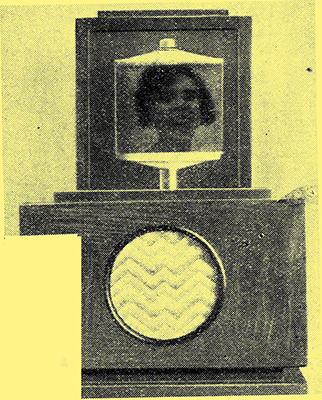
The Te-ka-de mirror screw television receiver.
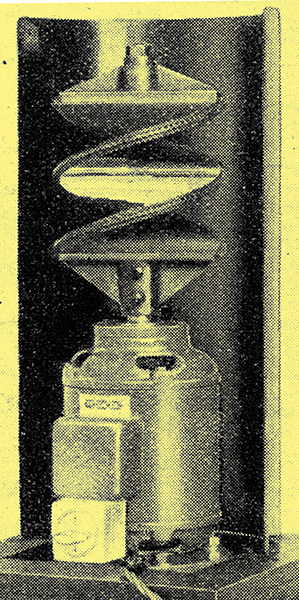
The mirror screw and motor of the Te-ka-de receiver.
As in former years, the Te-ka-de exhibited a mirror screw television receiver which is on sale and which this year also reproduces sound. A Te-ka-de novelty is a new type of Kerr cell for the control of the light ray.
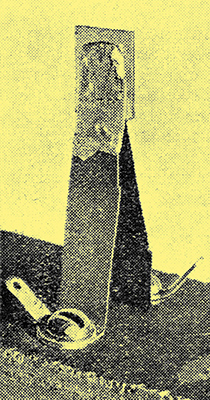
A crystal substitute for the Kerr cell. The crystal transparency varies , depending upon the potential applied across it.
This Kerr cell does not consist, as usual, of a small capacitor in nitro-benzole, but of a crystal through which the light passes. The crystal plate is coated on both sides with metal foil to which the modulating voltage is applied. Under the influence of this voltage the transparency is altered, linearly.
The firm of Loewe exhibited a cathode ray television receiver. The length of this cathode ray tube is 60 cm, the diameter of the fluorescent screen being about 25 cm. The lower portion of the apparatus contains the ultra-short wave receiver the 'Kipp' apparatus for controlling the tube, and a mains unit for providing the necessary voltages. The knobs on the left-hand side of the front regulate the volume for the loud speaker and the tuning of the short-wave receiver, the knobs on the right control the sharpness, and also the switching on and off of the mains current. The pictures demonstrated were extremely good. In the Loewe apparatus both sound and picture are received on the same receiver, but are they separated by two detector valves.
Telefunken also exhibited a television receiver with cathode ray tube. This, like the Loewe apparatus, has an ultra-short wave superheterodyne receiver.
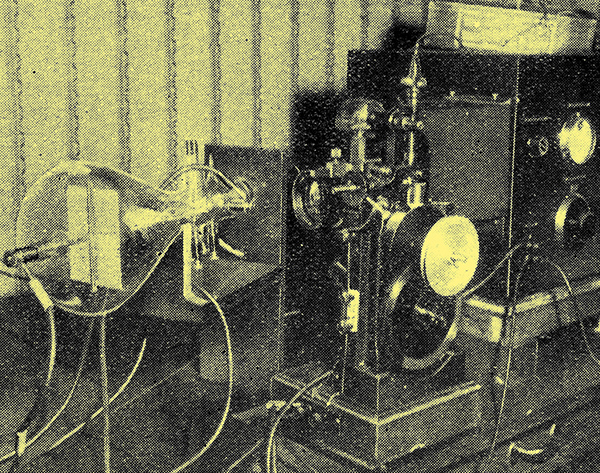
The new cathode ray tube equipment of von Ardenne, employing the principle of speed modulation.
M von Ardenne was showing his new cathode ray tube equipment, distinguished by the remarkable brightness of the light spot, so that the images can be observed on the screen in daylight or can be projected. The method used is that of 'line control' (speed modulation, in which a constantly bright spot of light travels over the field of view with varying velocity).
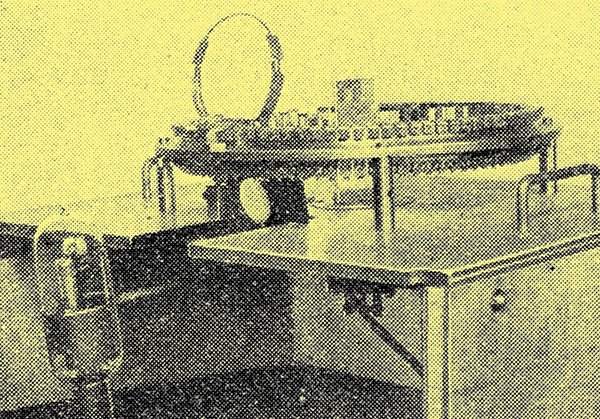
The new Mihaly mirror wheel apparatus; the complete receiver, which is enclosed in a cabinet, an external screen on a stand is provided and the picture is projected onto this screen from the receiver.
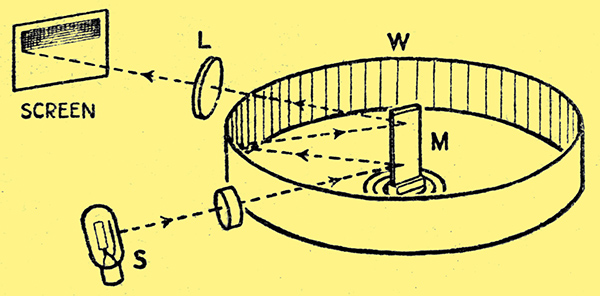
The new Mihaly mirror wheel apparatus. The diagram indicates the principle of operation.
Apart from the Post Office exhibits, which also made use of cathode ray tubes, the new mirror wheel process of Mihaly should be mentioned. This employs a Weiller mirror wheel, in which, however, the mirrors are on the inner side. The mirror wheel (see diagram) does not itself move, but inside it on its axis there is a small rotating plane mirror M, which is very light. This is driven by a small motor and kept in synchrony with the picture-changing frequency; a ray of light from a very strong source S is thrown on to this mirror, which reflects it on to the mirrors of the wheel. From here the ray is again led back to the little mirror which then projects it through a lens system on to the screen.
This extremely simple system would appear to have obvious advantages. The tiny rotating mirror only needs a very small and weak motor, which is no bigger than those used in synchronous electric clocks. As a result of this the driving and synchronising energy is extremely small. being only a fraction of a Watt in the ease of the latter. The energy can, therefore, be taken from the receiver itself, and thus the television transmitter controls the synchronism of the receiver.
At the Berlin Radio Exhibition this receiver was shown working off the 7 metre television transmitter. The image consisted of 90 lines (10,000 elements), there being 90 mirrors on the drum. In this receiver the small rotating mirror was silvered on both sides, so that the rotating speed need only be half of the picture speed, i.e., 750 rpm according to the British standard. The results on the 90-line receiver were pleasing, the detail being about equal to a 9 mm. home cinema outfit. The image size was about 6 by 8 inches. Synchronism was perfect, the picture being rock steady. The internal construction of the receiver can be clearly seen in the illustrations. The complete set contains the actual television portion, together bwith a 3 valve ultra-short wave receiver for AC mains.
A receiver for the new German standard of 180 lines will shortly be put into production. This model will probably employ a Kerr cell as a light source, thus giving brighter and black-and-white images. It is interesting to note that the regular television transmission service of the German Post Office employs ultra-short waves, the picture being horizontally scanned twenty-five times a second in ninety strips, the total number of picture elements or points being 10,000.
|